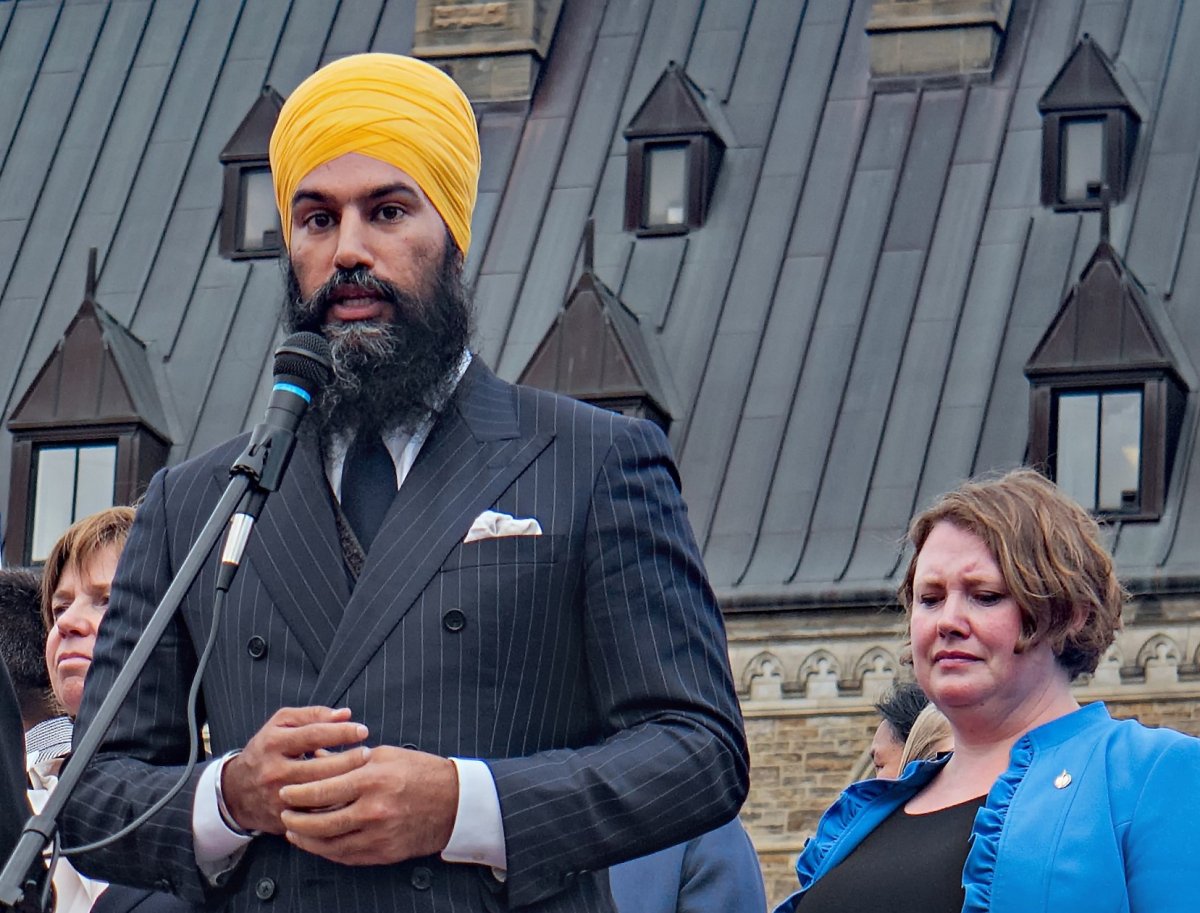Thank you for helping us meet our fundraising goal!
Out of everything that originally made Jagmeet Singh a fresh and unique party leader, it was his online persona that captured the nation’s eye. This began in 2017 with his GQ magazine feature and then continued with his handling of an Islamophobic heckler at a campaign meet-and-greet, both of which went viral and boosted his public profile.
For a politician, Singh was also an early adopter of TikTok and, leading into the 2019 election, used the app to talk about his party’s positions. At this point, he had established himself as “Gen-Z’s candidate” and his popularity was on the rise.
His peak relevance occurred in the period between the 2019 and 2021 elections. During the pandemic, Singh played Among Us on stream with several popular Twitch streamers and U.S. Representative Alexandria Ocasio-Cortez.
Watching that stream, I saw the vision. I understood the type of political movement Singh could lead in Canada given the right opportunity. The subsequent 2020 U.S. House of Representative elections came with wins for grassroots left-wing candidates like Cori Bush and Jamaal Bowman.
Singh’s association with the same online communities that fought for progressive results in the U.S., plus the internet’s general affinity towards him, made it feel like the ground was ripe for a big NDP result in the next election. One could only imagine how high the orange wave might crest.
But then the election happened, and there was no orange wave. The NDP gained just one seat, taking their total from 24 to 25. Singh and his party were left to review a highly disappointing result. But the party held the balance of power — the ability to give the Liberal’s a majority of votes in parliament — and so had the opportunity to pivot.
The NDP took it.
Today, the NDP sits in the shadow of the Liberal government, caught between criticizing those in power while also attempting to claim agency over bills being passed. Most peculiar of all has been Singh’s retreat from online spaces. In 2023, he deactivated his TikTok account citing privacy concerns, but the shift in the tone of his content went beyond that.
His once fresh, relatable, curtain-tearing content had been replaced by generic campaign videos of Singh reading scripts word-for-word that feel like they were copied directly from the platform section of the NDP website. It became boring, uninspired and — most importantly — ineffective. Polls now project a loss of seats for the NDP in the next election.
One thing is for certain: we are closer to a Singh exit than we are from his arrival. Come October, he will have been party leader for seven years — he will certainly not be leader in seven years. So, has his choice to abandon his online roots damaged the future of his party?
Since becoming Leader of the Conservative Party, Pierre Poilivre has mastered this era of the internet. I say ‘this era’ because internet culture moves fast and angles that worked even just months ago are now outdated.
Still, Poilivre has managed to stay on trend. His video thumbnails contain simple, bold and clearly worded statements that emulate the style of many top YouTubers. Poilievre is also willing to take more risks in his content approach. Take for example a video he made about inflation last year that he performed as a skit in a diner.
It was an artistic choice and one that resonated well with the commenters on that video. He is also able to capitalize on unscripted moments in a natural way. Look no further than his viral apple-eating interview. The Conservatives are on top of internet trends that the NDP are consistently late to and the Liberals don’t even know exist.
I do not believe that social media is the driving force behind election campaigns in Canada. Across the country, Canada’s working class is suffering. Inflation — while just recently falling to its lowest rate since March 2021 — has been high and grocery stores have continued to hike their prices post-pandemic, with the Bank of Canada reporting that prices had increased nearly 22 per cent between 2021 and 2024.
Understandably, Canadians have been looking for change and Poilivre’s Conservatives have been great at using online spaces to pitch themselves as the team who can deliver it. The NDP, whose roots are in labour organization, with a party leader who was working hard to foster an internet community just years ago, has fallen strangely silent — leaving many Canadians without any viable alternative to the current government besides the Conservatives.
Could a more focused NDP quench the tides of a potential Conservative majority government after the 2025 election? Probably not. There comes a tipping point in every Liberal government where the Conservatives will win a federal election regardless of who leads them. I do not believe that 2020’s version of Singh, lip-syncing to Fleetwood Mac while skating down the street, can alter that. However, had the NDP invested more time into online spaces, giving disenfranchised Canadians an alternative and creating a more current platform, they would have at least paved the way for the party’s future.
Rather than ditching those who championed him from the beginning, Singh should have rooted himself deeper within the online left. Then, at the minimum, he would have forged consistent messaging and been planted in a community that could sprout into a strong left-wing movement down the road.
As it stands, it’s very difficult to even imagine what shape the NDP would take under a Conservative government — which is not a very reassuring prospect. Remember that Singh has never worked in parliament — federal or provincial — while conservatives have been in power. There is no blueprint available for how he would handle this situation.
For three years, he has offered no insight whatsoever. Moving forward, the NDP feels utterly directionless.
Whatever the future of the NDP holds and whoever its next leader will be, it is clear that it remains a party in desperate need of reimagination — the exact same issue that Singh was brought in to solve.
David Cassels is a Toronto-based writer and researcher. He previously worked in Queen’s Park at the Ontario Association of Former Parliamentarians.






Comments
"Understandably, Canadians have been looking for change and Poilivre’s Conservatives have been great at using online spaces to pitch themselves as the team who can deliver it."
Sure if you are looking to take Canada backwards 5 decades. The conservative party is living in the past, but misusing modern tech to spread disinformation, in addition to using fake 3rd parties to also spread the same garbage. Unfortunately, too many people are naive and believe the garbage posted on social media and incapable of fact checking anything.
Singh and the NDP are a lost cause these days, riding on the coat tails of the Liberal party. But with that said, the NDP and Liberals are in serious need of new leadership that live in the current reality of climate change and economic times. But it seems both leaders plan to stick it out and inevitably crash and burn in the next election due to their own arrogance & delusions.
It is worrisome that Conservative base will vote for Pee Pee, who has yet to produce any real policies and side step any questions around women's rights. Pee Pee talks a lot, plenty of buzz words, hangs out with questionable cults, but his verbal diarrhea is void of any real substance.
That is all true, but it is also all beside the point the article is making. Poilievre's message sucks, yeah, and most of it is lies anyway, yeah, but the point is he's effective at delivering it, making very good use of modern communication channels, and for reasons I don't fully understand, other people I disagree with less are being ineffective at using those channels, and THAT'S A PROBLEM.
The NDP has for decades been very hesitant about their communications, because the media does not like them and they fear that telling it like it is will result in being called extremist commies. This is, in my opinion, not just cowardly but stupid. It just lets the "Overton Window" move, because if you abandon saying things X far left that are X% true out of fear of media criticism, the media will just start criticizing you for saying things X-1 far left that are X-1% true, until eventually people like fucking Barack Obama get called socialists. The NDP would be better off doing what the hard right do: Say what you mean and, if attacked for it, double down and attack back instead of backing up or being wishy-washy. Modern internet approaches make this easier, although gaming internet algorithms designed to promote controversial right wing but not left wing rhetoric are a complication.
Of course it may be that Singh just gave up after seeing one too many responses to his videos that threatened to rape and murder his wife and daughter, and the cops refusing to do anything.
There used to be this belief that high immigration rates would surely trend politics to the left, because immigrants suffer from racism, they have lower incomes, they're younger.
Not happening, is it? The NDP down 5% in polls today. The country that has taken in 10 million immigrants since 1990, with the total population 12 million larger, should surely not be in this place.
I'm feeling lost by it - can some heavy-duty survey efforts tease out where and why support for public services and the environment actually fell?
I think it's mostly about the social conservatism. Immigrants tend to be from places that are antifeminist, antigay and whatnot. Many may vote on the basis "Sure, Conservatives may ruin my LIFE, but they'll let me keep bossing my WIFE."
Also, never underestimate propaganda. Most people vote on the basis of false ideas about just what political parties stand for and what their policies do. Heck, lots of people still think "free markets" work well.
This article demonstrates why the Conservatives will probably win. The media, including the National Observer with this article, are more focused on tactics then policy. Let's talk about how the Conservatives are 'good' at social media but never talk about the abhorrent policies for those suffering from inflation. Never talk about the fundraising being done with the billionaires who own this country. Heaven forbid never talk about how the oil and gas industry manipulate Canadian politics to help their Conservative partner.
If the NDP really want to make a difference they should focus on where all the press are focused. They should focus on the Conservatives and reveal how truly vile they are and that they have no interest at all in helping the 'average' person.